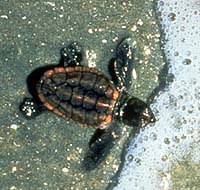Sea turtle
|
|
| Sea Turtles | ||||||||||||||||
|---|---|---|---|---|---|---|---|---|---|---|---|---|---|---|---|---|
 baby Loggerhead Sea Turtle | ||||||||||||||||
| Scientific classification | ||||||||||||||||
| ||||||||||||||||
| Genera | ||||||||||||||||
|
Caretta |
Sea turtles are large, ocean-dwelling turtles. There are seven species of sea turtle, all endangered. Sea turtles are found in all the world's oceans besides the Arctic Ocean, and some species travel between oceans. The Flatback turtle is found solely on the northern coast of Australia. The Leatherback is the largest, measuring six or seven feet (2 m) in length at maturity, and three to five feet (1 to 1.5 m) in width, weighing up to 1300 pounds (600 kg). Most other species are smaller being two to four feet in length (0.5 to 1 m) and proportionally less wide.
Different species are distinguished by varying anatomical aspects: for instance the prefrontal scales on the head, the number of and shape of scutes on the carapace, and the type of inframarginal scutes on the plastron. The Leatherback is the only sea turtle that doesn't have a hard shell instead carrying a mosaic of bony plates beneath its leathery skin.
Sea turtles have an extraordinary sense of time and location. They are highly sensitive to the Earth's magnetic field and probably use it to navigate. The fact that most species return to nest at the locations they were born at seems to indicate an imprint of that location's magnetic features. The ridley turtles are especially peculiar because instead of nesting individually like the other species, they come ashore in one mass arrival known as an "arribada" (the arrival). With the Kemp's ridley this occurs during the day and on only one beach in the entire world. The numbers used to range in the thousands but these days due to the effects of extensive egg poaching and hunting in previous years the numbers are in the hundreds.
After about 30 years of maturing an adult female sea turtle returns to the land to nest, usually on the same beach from which they hatched. This can take place every two to four years in maturity. They make from four to seven nests per nesting season. They dig a hole with their hind flippers and lay from 100 to 150 eggs in it (depending on the species) before covering it up and returning to the ocean. Some of the eggs are unfertilized 'dummy eggs' and the rest contain young turtles. Incubation takes about 2 months. When the eggs hatch, these baby turtles dig their way out and seek the ocean. Only a very small proportion of them (at most 1 in 100) will be successful, as many predators are waiting to eat them.
Threats to Sea Turtles
Sea turtles of all species are endangered. The Leatherback, Kemp's ridley, and Hawksbill turtles are listed as Critically Endangered. The Olive ridley, Loggerhead, and Green turtles are considered Endangered. The Flat back is considered Data Deficient due to lack of research. They used to be hunted on a large scale in the whaling days for their meat, fat and shells. And coastal peoples have always gathered turtle eggs for consumption. These days though their biggest threat comes from long-line fishing, and as bycatch in shrimp nets, as well as over development on nesting beaches. Each year it is said that 40,000 turtles die from longlines alone. According to researchers at the 24th Annual Symposium on Sea Turtle Conservation and Biology, in Costa Rica the Pacific Leatherback has ten years before extinction if nothing is done to reverse these problems. Small and inexpensive changes to fishing techniques, such as slightly larger hooks and traps from which sea turtles can escape, can dramatically cut the mortality rate. Another danger comes from marine debris, from especially abandonded fishing nets in which they can become entangled.
Beach development is another very, very large area which has threatened sea turtles. Since sea turtles return to the same locations to nest, these areas may be protected by special police. In some areas, such as the East coast of Florida, after the adult turtles lay their eggs, they are dug up and relocated to special fenced nurseries where they can be protected from beach traffic. This is not the best thing to do, as the turtles return to the beach they were born in which might be dangerous. Special lighting ordinances may also be enforced to prevent lights from shining on the beach and confusing young hatchlings from thinking it is the moon or sun and crawling toward it, usually crossing a road.
One of the biggest threats to sea turtles is the black market trade in eggs and meat. This is a pervasive problem throughout the world, but especially a concern in India, Indonesia and throughout the coastal nations of Latin America. Estimates are as high as 35,000 turtles killed a year in Mexico and the same number in Nicaragua. Conservationists in Mexico and the United States have launched "Don't Eat Sea Turtle" campaigns in order to reduce the urban black market trade in sea turtle products. These campaigns have involved figures such as Pope John Paul, Dorismar, Los Tigres del Norte and Mana. Template:AnimalClipart marine


